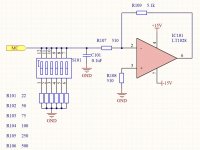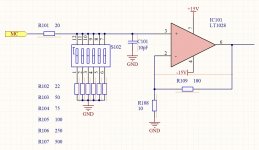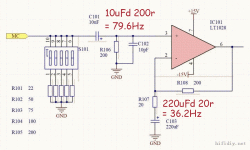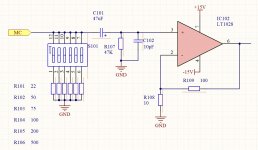My design uses LT1028 as MC cartridge 10x linear amplification.Then connect the following LT1057 for RIAA amplification.Then use LT1057 for last balanced amplification.Now I have designed a circuit diagram of MC cartridge reverse current amplification with LT1028. I directly couple MC cartridge to LT1028, and the input resistance R107 is 510 ohms. I have a question to ask everybody, will this direct coupling burn the MC cartridge when LT1028 is powered on? Thank you!


Attachments
Last edited:
Using LT1028 in inverting mode comes with a noise penalty. Putting 510ohm in series with the source means the 1nV/rtHz noise performance of this beautifully quiet beast of an opamp is really wasted as 510ohm comes with about 3nV/rtHz thermal noise itself.
My design uses LT1028 as MC Phono 10x linear amplification.Then connect the following LT1057 for RIAA amplification.Then use LT1057 for last balanced amplification.Now I have designed a circuit diagram of MC Phono reverse current amplification with LT1028. I directly couple MC Phono to LT1028, and the input resistance R107 is 510 ohms. I have a question to ask everybody, will this direct coupling burn the MC Phono when LT1028 is powered on? Thank you!
Yes, if the opamp saturates it will push several mA through the cartridge - whereas the normal non-inverting amp only has sub-microamp levels of current from the chip.
And as pointed out the inverting configuration is unworkable from a noise perspective - non-inverting with gain for low-noise front-ends, you don't want series resistance adding Johnson noise onto the signal.
100nF for load cap is rather high. That's only 80 ohms impedance at 20kHz.
For the MM / RIAA section the LT1057 has rather a lot of voltage noise - there are better low noise JFET opamps with 4nV or lower, and even the NE5534A will do fine and out-perform the LT1057 I suspect.
Using LT1028 in inverting mode comes with a noise penalty. Putting 510ohm in series with the source means the 1nV/rtHz noise performance of this beautifully quiet beast of an opamp is really wasted as 510ohm comes with about 3nV/rtHz thermal noise itself.
Thank you for your reply. It seems that there is a problem with LT1028 as reverse amplification
Yes, if the opamp saturates it will push several mA through the cartridge - whereas the normal non-inverting amp only has sub-microamp levels of current from the chip.
And as pointed out the inverting configuration is unworkable from a noise perspective - non-inverting with gain for low-noise front-ends, you don't want series resistance adding Johnson noise onto the signal.
100nF for load cap is rather high. That's only 80 ohms impedance at 20kHz.
For the MM / RIAA section the LT1057 has rather a lot of voltage noise - there are better low noise JFET opamps with 4nV or lower, and even the NE5534A will do fine and out-perform the LT1057 I suspect.
Thank you for your reply. I redesigned a LT1028 forward linear amplifier circuit for MC cartridge .I added 20 ohm R101 and MC cartridge in series to protect MC cartridge in case of power on or circuit failure, I don't know whether it has an effective effect. I didn't increase the coupling capacitance from MC cartridge to LT1028 forward end, which may damage MC cartridge ? Thank you

Attachments
Last edited:
The 20R is too small. A resistor that would limit the current to a safe value would be far too large,
so use a coupling capacitor instead.
so use a coupling capacitor instead.
I designed a forward amplification diagram with DC input coupling capacitance. There is a contradiction here. R106 and the input resistance array form an input impedance in parallel. If the input impedance is high, the value of R106 must also be high, which increases the noise of the LT1028 amplification circuit. I compromised to make the maximum input impedance 100 Ω. If this diagram is feasible, I can design the circuit diagram behind.


Attachments
R106 only matters for noise purposes when there's no cartridge connected and at low freqs. With an input source, R106 is in parallel with the moving coil. C101 (and C103) should be a bipolar type (or two back-to-back polarized 'lytics) as there's no telling which polarity IC101's input offset is. I suspect that C101 needs to have a higher value not to increase the LF noise - I'd go up to 100uF (or two back-to-back 220uFs)
...I suspect that C101 needs to have a higher value not to increase the LF noise...
Not just subsonic rumble. Both time constants cut a lot of bass.
Attachments
Thank you for your correction. I didn't calculate the frequency bandwidth in detail. I redesigned a graph and posted it on the previous post. If there are any questions, please correct them. Thank you!Not just subsonic rumble. Both time constants cut a lot of bass.
Not just subsonic rumble. Both time constants cut a lot of bass.
I wasn't thinking of noise from the source, just noise from the opamp's own input current. With a low value of C the effective source impedance rises at LF, meaning the noise current gets more 'gain' at LF. But with 200R input resistance the rise will be quite limited.
I wasn't thinking of noise from the source, just noise from the opamp's own input current.....
Sorry, I was not clear enough. By "subsonic rumble" I was thinking device random noise. Not platter or room rumble. I have made this mistake and had the woofer flapping and the speaker amp cutting-out from the random subsonics.
Ah - I saw the word 'rumble' and automatically assumed it was coming from the source. Thanks for clarifying.
Incidentally over on another thread recently I saw @Bonsai singing the praises of AD797 in terms of absence of LF nose. Which prompted me to compare AD797 with LT1028 in that department. LT1028 wins handsomely with a considerably lower 1/f noise corner. Here in China LT1028 is very affordable as recycled ones are available.
Incidentally over on another thread recently I saw @Bonsai singing the praises of AD797 in terms of absence of LF nose. Which prompted me to compare AD797 with LT1028 in that department. LT1028 wins handsomely with a considerably lower 1/f noise corner. Here in China LT1028 is very affordable as recycled ones are available.
Last edited:
Maybe the LT1028 seems to win on specs because of correlated input current compensation which only produced the noise figures when both inputs see exactly the same impedance.
That’s why the figures in practice are worse than expected.
The AD797 also has input current compensation, but to a much lower degree.
In the end the AD797 is the better op-amp also because the LT1028 had a strange noise jump at HF.
Somewere on this forum I have measured a number of both op-amps in a special thread, showing that the LT1028 does not meet it specs, while the AD797 does.
Hans
That’s why the figures in practice are worse than expected.
The AD797 also has input current compensation, but to a much lower degree.
In the end the AD797 is the better op-amp also because the LT1028 had a strange noise jump at HF.
Somewere on this forum I have measured a number of both op-amps in a special thread, showing that the LT1028 does not meet it specs, while the AD797 does.
Hans
- Home
- Source & Line
- Analogue Source
- I'm going to use LT1028 and LT1057 to make a MC/MM LP player preamp






